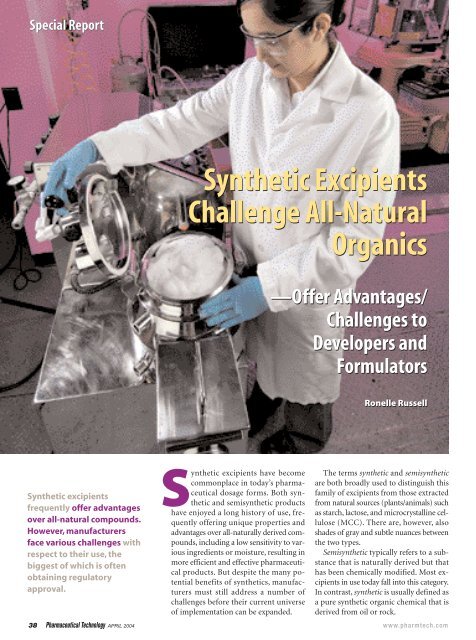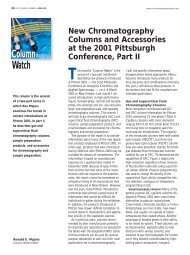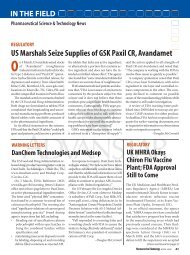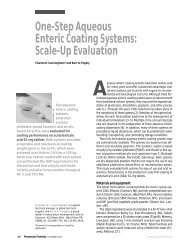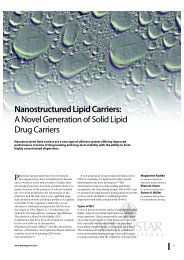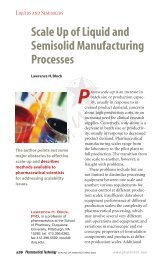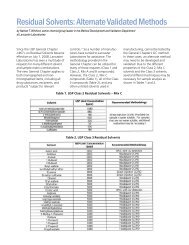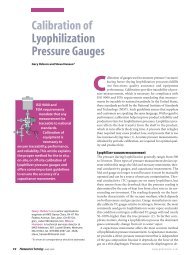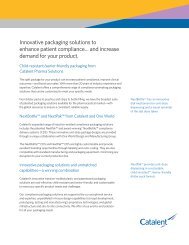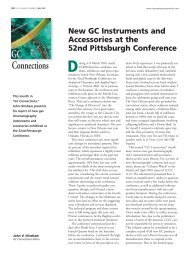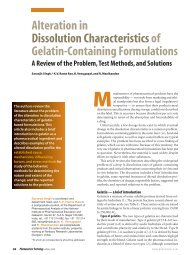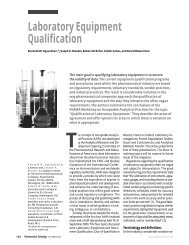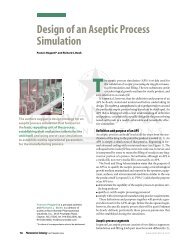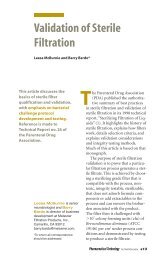Synthetic Excipients Challenge All-Natural Organics Synthetic ...
Synthetic Excipients Challenge All-Natural Organics Synthetic ...
Synthetic Excipients Challenge All-Natural Organics Synthetic ...
Create successful ePaper yourself
Turn your PDF publications into a flip-book with our unique Google optimized e-Paper software.
Special Report<br />
<strong>Synthetic</strong> <strong>Excipients</strong><br />
<strong>Challenge</strong> <strong>All</strong>-<strong>Natural</strong><br />
<strong>Organics</strong><br />
—Offer Advantages/<br />
<strong>Challenge</strong>s to<br />
Developers and<br />
Formulators<br />
Ronelle Russell<br />
<strong>Synthetic</strong> excipients<br />
frequently offer advantages<br />
over all-natural compounds.<br />
However, manufacturers<br />
face various challenges with<br />
respect to their use, the<br />
biggest of which is often<br />
obtaining regulatory<br />
approval.<br />
<strong>Synthetic</strong> excipients have become<br />
commonplace in today’s pharmaceutical<br />
dosage forms. Both synthetic<br />
and semisynthetic products<br />
have enjoyed a long history of use, frequently<br />
offering unique properties and<br />
advantages over all-naturally derived compounds,<br />
including a low sensitivity to various<br />
ingredients or moisture, resulting in<br />
more efficient and effective pharmaceutical<br />
products. But despite the many potential<br />
benefits of synthetics, manufacturers<br />
must still address a number of<br />
challenges before their current universe<br />
of implementation can be expanded.<br />
The terms synthetic and semisynthetic<br />
are both broadly used to distinguish this<br />
family of excipients from those extracted<br />
from natural sources (plants/animals) such<br />
as starch, lactose, and microcrystalline cellulose<br />
(MCC). There are, however, also<br />
shades of gray and subtle nuances between<br />
the two types.<br />
Semisynthetic typically refers to a substance<br />
that is naturally derived but that<br />
has been chemically modified. Most excipients<br />
in use today fall into this category.<br />
In contrast, synthetic is usually defined as<br />
a pure synthetic organic chemical that is<br />
derived from oil or rock.<br />
38 Pharmaceutical Technology APRIL 2004 www.pharmtech.com
Special Report<br />
An excipient's path to the National Formulary<br />
After a new excipient has been used in an<br />
FDA-approved drug, the excipient manufacturer<br />
can submit a monograph of the excipient<br />
to the United States Pharmacopeia (USP).<br />
USP's web site, www.usp.org, posts the requirements<br />
for new submissions, called “Requests<br />
for Revision,” and details what should<br />
be included in the submission package.<br />
Once USP receives the company's submission,<br />
it first makes an initial evaluation of the<br />
completeness of the data. If it determines that<br />
all the required data are included, it will send<br />
the submission on to an expert committee for<br />
review. The committees are generally composed<br />
of representatives from the pharmaceutical<br />
manufacturing industry, government (including<br />
FDA), and academia.<br />
The expert committee will then make a<br />
more-thorough evaluation of the submission<br />
package. If accepted, it will be incorporated in<br />
the Pharmacopeial Forum (PF), which is published<br />
every other month, for public review<br />
and comment. Anyone with an interest in that<br />
excipient, called a stakeholder, can send comments,<br />
but those comments must be substantiated<br />
with appropriate data or reasonable<br />
information.<br />
After the comments are received, the complete<br />
package is sent back to the expert committee.<br />
If there are no comments, the monograph<br />
proposal is voted on by the expert<br />
committee to become an official monograph<br />
in the USP–NF after a minimum of 60 days<br />
(typically 90 days) have passed since its publication<br />
in the PF.<br />
When there are comments, the committee<br />
will decide whether to revise the monograph<br />
accordingly or to reject them. If the monograph<br />
is revised, then it must be published in the PF<br />
a second time, then can be voted to become an<br />
official monograph 60 days after publication.<br />
If a monograph requires only one publication<br />
in the PF, it can become official in approximately<br />
6–8 months. When a second publication<br />
cycle is required, the entire process can take<br />
15 months or longer.<br />
Excipient manufacturers easily disagree with<br />
these definitions when describing their products<br />
because so much chemistry is involved in the manufacturing<br />
process. As a result, the term synthetic is<br />
frequently used to encompass both types.<br />
Applications and advantages<br />
<strong>Synthetic</strong> excipients are used in the manufacture<br />
of tablets to bind the tablet together, reduce diewall<br />
friction between the tablet and the tableting<br />
press, control pH balance, and to disintegrate<br />
the tablet in the stomach once it has been ingested.<br />
They’re used for just about every function<br />
of an inactive ingredient except as bulking<br />
agents, which are usually natural products. In<br />
parenterals, synthetics are used as solubilization<br />
agents to make actives more soluble, and therefore,<br />
more deliverable.<br />
<strong>Synthetic</strong>s also offer other benefits over natural<br />
excipients. Because they’re not extracted<br />
from animal materials, they’re free of transmissible<br />
diseases—a characteristic that may be of<br />
increased importance among manufacturers and<br />
regulators in light of the recent case of a BSEinfected<br />
cow found in the United States last year.<br />
The absence of plant or animal material in synthetics<br />
also eliminates concerns posed by genetically<br />
modified organisms (GMOs), which can<br />
also interfere with the safety and acceptability of<br />
a drug formulation.<br />
Another benefit of synthetics compared with<br />
natural excipients is that they can be produced to<br />
a certain specification because there is more control<br />
over the manufacturing process. Most naturalbased<br />
polymers aren’t chemically identical because<br />
of the variability that exists in nature. For<br />
example, depending on changes in weather from<br />
one year to the next, the structure and properties<br />
of natural materials can also vary slightly—an effect<br />
avoided with synthetics, which are synthesized<br />
in chemical reactors.<br />
Joseph Zeleznik, senior scientist at excipients<br />
manufacturer JRS Pharma (Patterson, NY), points<br />
to magnesium stearate as a good example of a natural<br />
material versus a synthetic. “Manufacturing<br />
controls are just not that stringent because they<br />
can’t be. Because magnesium stearate is a naturally<br />
derived product, it possesses a great deal of<br />
inherent variability—not only from batch to batch<br />
but from manufacturer to manufacturer as well,”<br />
says Zeleznik.<br />
Such variability in natural excipients can be problematic<br />
for drug manufacturers because once their<br />
formulation has been approved by FDA, it becomes<br />
difficult to change the formulation components or<br />
component levels that were used in the clinical trials.<br />
If any variability exists, either in the raw materials<br />
or manufacturing process, a company will have<br />
to spend more time and money proving that there<br />
are no adverse effects as a result of the change.<br />
40 Pharmaceutical Technology APRIL 2004 www.pharmtech.com
Special Report<br />
Lipophilic drugs form an<br />
equilibrium complex with<br />
the lipophilic cavity of<br />
cyclodextrin molecules,<br />
minimizing their interaction<br />
with water. The hydrophilic<br />
nature of the exterior of the<br />
cyclodextrin provides water<br />
solubility for the drugcyclodextrin<br />
complex.<br />
Eric Smith, vice-president of marketing at JRS,<br />
agrees with Zeleznik. “Even slight changes, such<br />
as in particle size, can affect the drug release profile,”<br />
Smith says. “Our industry is really exacting<br />
with specifications.”<br />
JRS Pharma manufactures the excipient “Pruv”<br />
(sodium stearyl fumarate), which is used as a<br />
boundary lubricant (i.e., it coats the powder particles<br />
in formulations) and also helps reduce interparticulate<br />
friction to enhance formulation flow<br />
onto the tablet press. “Lubrication is a very sensitive<br />
function within the tableting process,” Smith<br />
states. “The key is to produce a synthetic material<br />
that always delivers the same lubricity level to<br />
the formulation.” Because of the sensitivity of the<br />
lubrication function, companies impose strict<br />
specifications on manufacturing processes to ensure<br />
the predictability of products.<br />
Bringing new synthetic excipients<br />
to market<br />
One of the main challenges facing synthetic excipient<br />
manufacturers, as they drive toward higher<br />
market share, is the difficulty involved in bringing<br />
a new synthetic excipient to market.<br />
According to Lou Blecher, former chairman of<br />
the International Pharmaceutical <strong>Excipients</strong><br />
Council (IPEC) and now a consultant to excipient<br />
manufacturers, this particular challenge is a<br />
“virtual impossibility” for synthetics manufacturers.<br />
As Blecher explains, because FDA has no<br />
regulatory body to review excipients separately<br />
from formulations, they’re only approved as part<br />
of a new drug application (NDA) or investigational<br />
new drug (IND). In addition, the United<br />
States Pharmacopeia (USP) will not add any excipients<br />
to its National Formulary unless the excipient<br />
has been used in at least one FDA-approved<br />
product.<br />
Although these regulatory issues may sound<br />
like obstacles in and of themselves, the real difficulty<br />
lies in convincing drug manufacturers to use<br />
a new excipient in a formulation. Typically, manufacturers<br />
won’t risk product approval with a novel<br />
synthetic unless that particular excipient provides<br />
a unique function essential to the formulation.<br />
“Why would you ask for the extra trouble of having<br />
to explain something to the FDA reviewer<br />
that he or she has never seen before?” Blecher<br />
queries. “It’s much easier to stick with materials<br />
that are already accepted than to monkey<br />
around with something new.”<br />
Lokesh Bhattacharyya, PhD, director of the<br />
noncomplex actives and excipients division in<br />
the information and standards development<br />
program at USP, agrees with Blecher and adds<br />
that because the functions of new excipients<br />
are less understood, there’s more concern about<br />
their affect on the bioavailability of a drug product.<br />
“Anything new will get more scrutiny,” he<br />
says. “A new excipient will require a greater level<br />
of categorization.”<br />
Finding profitable applications. For a drug manufacturer<br />
to consider using a novel synthetic excipient<br />
(a brand new chemical that has not been<br />
used in drugs before), the excipient manufacturer<br />
will have to develop the same amount of safety<br />
data required for a new drug, which is both costly<br />
and time consuming. This fact alone prevents<br />
many synthetics providers from developing new<br />
products unless there’s a specific application for<br />
the novel excipient that can outweigh the costs of<br />
safety testing and prove profitable for the company.“If<br />
it’s not the only thing permitting an antitumor<br />
agent from being marketed, are you going<br />
to spend the money looking?” asks Blecher.<br />
CyDex, Inc. (Lenexa, KS) decided it would<br />
spend the money when it produced its novel excipient,<br />
“Captisol” (modified beta-cyclodextrin).<br />
Captisol, which is considered a semisynthetic excipient<br />
because it’s a chemical modification of<br />
parent cyclodextrins that occur in nature, works<br />
as a solubilization agent, allowing anticancer<br />
agents to be delivered parenterally to the body.<br />
The development of Captisol was motivated by<br />
an overall interest in the use of cyclodextrins for<br />
parenteral formulations. Beta-cyclodextrin can’t<br />
be used in parenteral formulations because, upon<br />
systemic administration, it causes extensive hemolysis<br />
and dramatic nephrotoxicity. Researchers<br />
such as those at the University of Kansas explored<br />
modifications of the parent cyclodextrins in search<br />
of derivatives that would have good systemic safety<br />
profiles while retaining or improving the functional<br />
complexation characteristics of the parent<br />
cyclodextrins.<br />
Because the safe delivery of anticancer agents<br />
is such a strong need in the industry, CyDex decided<br />
it was a viable application for this type of<br />
excipient. Doug Hecker, director of operations at<br />
CyDex, states that it’s best for a manufacturer if<br />
an application for a new excipient comes from the<br />
customers themselves.“It’s easier to solve a known<br />
problem than to try to find a problem and then<br />
42 Pharmaceutical Technology APRIL 2004 www.pharmtech.com
Special Report<br />
Plasdone (povidone) with tablet punches.<br />
solve it,” he says. Hecker also explains that the<br />
unique properties of Captisol make it the kind of<br />
excipient that actually helps bring certain drugs<br />
to market that otherwise couldn’t move forward<br />
into clinical studies. “We provide an alternative<br />
that helps with a formulation, and in some instances,<br />
makes the formulation,” he states.“It’s an<br />
enabling technology.” Captisol is currently used<br />
in four approved parenteral products—two in the<br />
United States and in two in Europe.<br />
Receiving GRAS status. One way that many new<br />
excipients make it into oral dosage formulations<br />
is by using materials that FDA classifies as generally<br />
recognized as safe (GRAS). However, GRAS<br />
status primarily applies to materials that are also<br />
used as food additives, and requires companies to<br />
submit a food additive petition to FDA.<br />
In some instances this is a viable option, because<br />
many excipients in use today are materials<br />
that were, in fact, previously used in the food industry.<br />
However, Captisol represents an example<br />
where this wasn’t the case. Captisol isn’t used in<br />
food, and although it does have some applicability<br />
in oral formulations, it’s main use is for solubilizing<br />
drugs for injectable products.<br />
Assembling a Drug Master File. Although CyDex<br />
may apply for GRAS status for Captisol in the future,<br />
it has, in the meantime, still been able to promote<br />
its products to drug manufacturers because<br />
its safety and chemistry, manufacturing, and controls<br />
(CMC) data are available in a Type 5 Drug<br />
Master File (DMF). Whenever a drug containing<br />
Captisol is in clinical trials, CyDex provides the<br />
company with a letter of authorization to the DMF<br />
that allows FDA to review the safety information<br />
about the novel-enabling excipient. Although drug<br />
formulators aren’t required to supply FDA with a<br />
DMF when using a new excipient in their formulations,<br />
a DMF can be helpful to FDA reviewers<br />
during the drug approval process, and formulators<br />
are always looking for additional information<br />
that will help them get their drugs approved.<br />
“GRAS status applies to use in foods and often<br />
The molecular structure of Pharmasolve (N-methyl-2-<br />
pyrrolidone).<br />
The molecular structure of Plasdone (povidone).<br />
translates into some broad acceptability for use<br />
in pharmaceuticals,” says J.D. Pipkin, PhD, director<br />
of product development at CyDex.“But if your<br />
product doesn’t have GRAS status, then you have<br />
to supply your safety data and be convincing with<br />
it for each and every application,” he says.<br />
Coprocessing. Another way that new synthetic<br />
excipients are coming to market without undergoing<br />
the rigorous safety testing of a completely<br />
new chemical is by coprocessing previously accepted<br />
materials such as two already-established<br />
excipients. Many synthetic and semisynthetic<br />
manufacturers, such as International Specialty<br />
Products (ISP, Wayne, NJ), are using this approach<br />
to add new excipients to their product base. “If<br />
there’s a drug application in which none of the<br />
standard excipients will work, then you have to<br />
look for something new,” says Tim Bee, PhD,<br />
director of marketing pharmaceuticals at ISP.“But<br />
44 Pharmaceutical Technology APRIL 2004 www.pharmtech.com
Special Report<br />
Special Report<br />
in most cases you can use the standard ingredients in different<br />
ways to do what you need to do.”<br />
Bee doesn’t see a broad-based need for totally new synthetic<br />
excipients for basic tablets or parenterals, which means that<br />
companies like ISP must look for other ways to grow. “No customers<br />
are coming out and saying that they need a significantly<br />
better tablet binder,” he says.“They would certainly love to have<br />
something that worked better, but something that would be<br />
chemically totally different would require too much new safety<br />
data and would be difficult to justify economically without a<br />
strong market pull.” Though Bee agrees that some niche applications<br />
in drug delivery and targeted-release formulations do<br />
need new excipients, he feels that, “for most areas, totally new<br />
materials are not required.”<br />
ISP has addressed this lack of new applications by providing<br />
new ways of processing previously-accepted materials that can<br />
help lower drug manufacturers’ costs or extend the patent life<br />
of their drug. “An excipient manufacturer has to focus on providing<br />
tablet manufacturers new ways of doing things because<br />
pharmaceutical companies are also looking to offer new things<br />
to consumers,” Bee says.<br />
USP’s Bhattacharyya agrees, but adds that as more new products<br />
such as aerosols, modified-release tablets, and a variety of<br />
new drug-delivery systems come to market, there will be opportunities<br />
for excipient manufacturers to develop all-new excipients<br />
as well. “Everyday we hear about new, more-effective,<br />
easily deliverable products. These new products will need new<br />
excipients that are suitable for new and novel formulations,”<br />
says Bhattacharyya.<br />
ISP currently manufactures “Plasdone” products (povidone),<br />
which are used as tablet binders and as solubilization agents in<br />
parenterals; “Polyplasdone” (crospovidone), a disintegrant;<br />
“PharmaSolve” (N-methyl-2-pyrrolidone), a solubilization agent<br />
for parenterals; and “Cavamax” (cyclodextrins), a solubilization<br />
agent sold by ISP through an alliance with Wacker-Chemie<br />
GmbH (Munich, Germany).<br />
Getting an excipient monograph in USP’s<br />
National Formulary<br />
Once a new excipient has become part of an FDA-approved formulation,<br />
the excipient manufacturer can submit a proposed<br />
monograph to USP to be included in the National Formulary<br />
(NF), one of two compendia included in the USP–NF.The pharmacopeia<br />
will then develop a quality standard (also called a<br />
monograph) for the new excipient through a scientific-review<br />
process that begins with evaluation by an expert committee and<br />
includes an opportunity for public comment. The entire process<br />
can take anywhere from 6 to 15 months (see Sidebar, “An excipient’s<br />
path to the National Formulary”).<br />
After the review process is complete, the monograph is then<br />
added to the USP–NF,which provides validated analytical procedures<br />
and associated acceptance criteria for drug substances,<br />
products, and excipients.<br />
There are a variety of reasons why excipient manufacturers<br />
would want their novel excipients to be included in the USP–NF.<br />
First, the formulary publishes the highest quality standard for<br />
the product publicly available, giving drug manufacturers more<br />
46 Pharmaceutical Technology APRIL 2004 www.pharmtech.com
Special Report<br />
The sulfobutylether<br />
substituents on Captisol<br />
enhance complexation by<br />
providing an extended<br />
hydrophobic cavity and an<br />
extremely hydrophilic<br />
exterior surface.<br />
confidence in the quality of the product, which<br />
can translate into higher sales for an excipient<br />
company.<br />
Also, if there’s another manufacturer for the same<br />
excipient subsequent to the development of the<br />
monograph, then it will have to comply with the<br />
quality standard already published in NF.Consequently,<br />
the company that submits a new monograph<br />
has a greater role in developing the tests, procedures,<br />
and acceptance criteria that should be performed<br />
when evaluating quality of the substance.<br />
And when drug manufacturers buy NF-grade<br />
materials for their products, they can be assured<br />
that the appropriate tests and procedures have<br />
been used, and that the quality standard is appropriate<br />
for their product. FDA inspectors also<br />
have a high degree of confidence in NF-grade materials<br />
and generally will not question the tests<br />
and acceptance criteria used.<br />
Must-have GMPs.The path to inclusion of an excipient<br />
monograph in the National Formulary is<br />
not without obstacles, however. For example, one<br />
potential difficulty is that USP requires the excipient<br />
to be manufactured using good manufacturing<br />
practices (GMPs) for pharmaceuticals.<br />
Since, in many cases, the excipient material is<br />
used primarily in other applications such as food,<br />
cement, or paint, which don’t require the same<br />
level of manufacturing standards, manufacturers<br />
will often have to incur significant additional<br />
cost to meet the USP’s GMP requirements.<br />
“We’re working with excipient manufacturers<br />
to come to a mutually acceptable approach in<br />
48 Pharmaceutical Technology APRIL 2004 www.pharmtech.com
Special Report<br />
these areas,” says USP’s Bhattacharyya.“The quality<br />
versus cost issue is a difficult one, and we always<br />
have to find a balance.”<br />
Incomplete data and proprietary information. Another<br />
potential problem is within the monograph<br />
submission itself. If a company doesn’t provide<br />
complete data in the submission, valuable time<br />
can be lost.<br />
Misunderstanding or inexperience with the<br />
process requirements may not always be the reason<br />
for an incomplete submission. Sometimes<br />
companies deliberately withhold data because of<br />
concerns about releasing proprietary information.<br />
Although he understands these concerns, Bhattacharyya<br />
notes that this can be a problem, because<br />
the expert committee has a responsibility<br />
to decide what data are necessary to develop an<br />
appropriate quality standard.“Though we respect<br />
the manufacturers’ need for proprietary information,<br />
we also don’t compromise on the highest<br />
level of quality standards,” explains Bhattacharyya.<br />
USP has a document disclosure policy<br />
that serves to protect confidential information<br />
and intellectual property rights. “In almost all<br />
cases, we finally come to an agreement, but it can<br />
take a considerable amount of time,” he says.<br />
Future of synthetic excipients<br />
JRS’s Smith believes that coprocessing could hold<br />
the key to a successful future for synthetic excipients<br />
by ushering in a new class of multifunctional<br />
compounds. “It’s a formulation industry, therefore<br />
people are always coming up with different<br />
excipient combinations,” says Smith. “Formulators<br />
have many tools they can use to obtain their<br />
defined dissolution rate. A new excipient is just<br />
another tool.”<br />
Blecher agrees with Smith’s forecast and adds<br />
that synthetics and semisynthetics will be used by<br />
the industry for many years to come, as long as<br />
excipient manufacturers keep finding new ways<br />
to make things simpler for the drug formulator.<br />
“Anything that will do the job better, more efficiently,<br />
and more dependably will always be of interest,”<br />
states Blecher.PT<br />
Please rate this article.<br />
On the Reader Service Card, circle a number:<br />
336 Very useful and informative<br />
337 Somewhat useful and informative<br />
338 Not useful or informative<br />
Your feedback is important to us.<br />
50 Pharmaceutical Technology APRIL 2004 www.pharmtech.com


